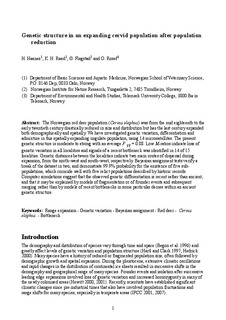Genetic structure in an expanding cervid population after population reduction
Journal article, Peer reviewed
Permanent lenke
http://hdl.handle.net/11250/2438036Utgivelsesdato
2009Metadata
Vis full innførselSamlinger
Sammendrag
The Norwegian red deer population (Cervus elaphus) was from the mid eighteenth to the early twentieth century drastically reduced in size and distribution but has the last century expanded both demographically and spatially. We have investigated genetic variation, differentiation and admixture in this spatially expanding ungulate population, using 14 microsatellites. The present genetic structure is moderate to strong with an average F ST = 0.08. Low M-ratios indicate loss of genetic variation in all localities and signals of a recent bottleneck was identified in 14 of 15 localities. Genetic distances between the localities indicate two main routes of dispersal during expansion, from the north–west and south–west, respectively. Bayesian assignment tests verify a break of the dataset in two, and demonstrate 99.9% probability for the existence of five sub-populations, which coincide well with five relict populations described by historic records. Computer simulations suggest that the observed genetic differentiation is recent rather than ancient, and that it may be explained by models of fragmentation or of founder events and subsequent merging rather than by models of recent bottlenecks in some particular demes within an ancient genetic structure.
